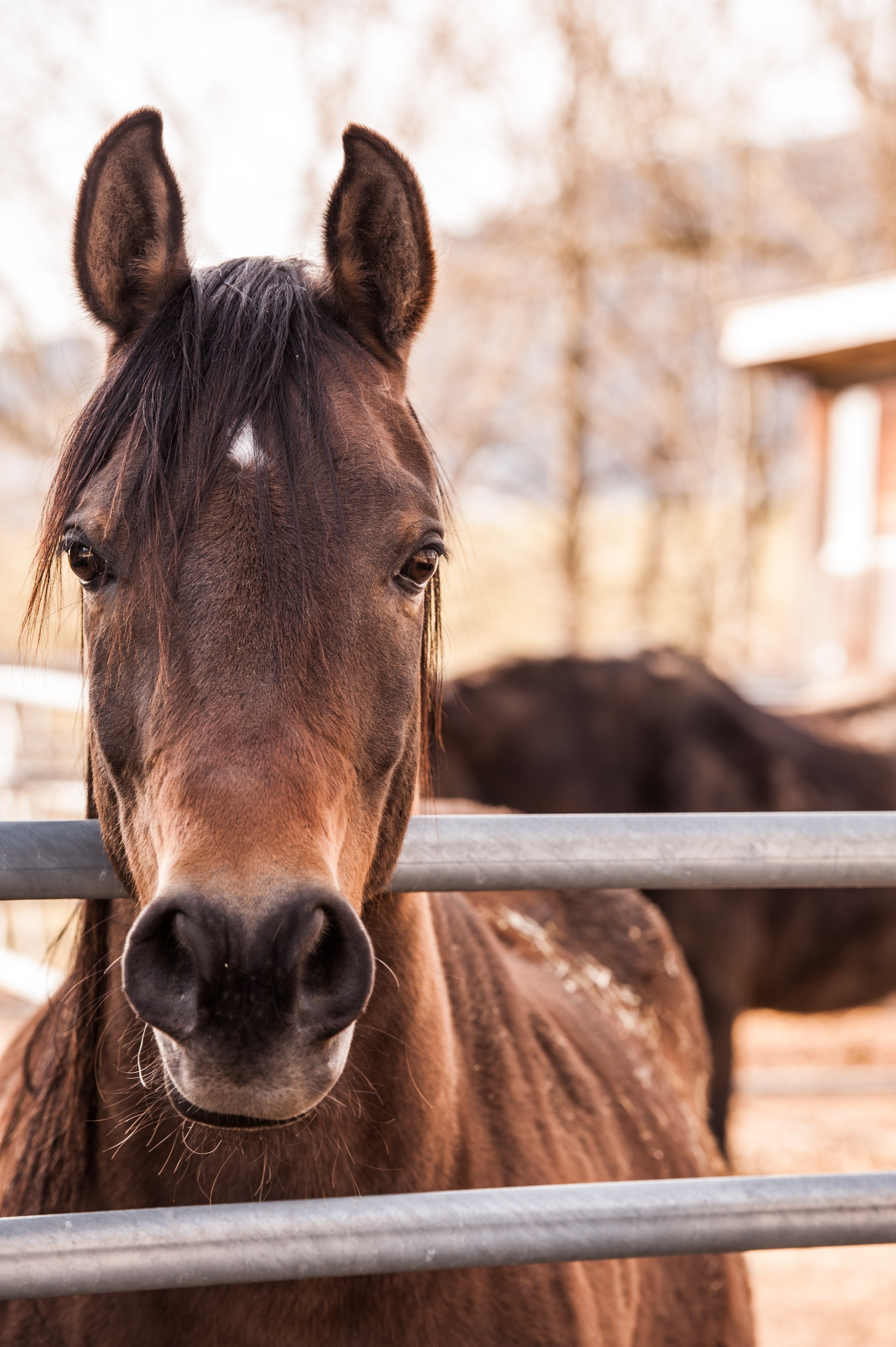Estudios sobre la eficacia del pirantel para el control de los pequeños estróngilos en equinos del área central de la Argentina
DOI:
https://doi.org/10.14409/favecv.2023.22.e0024Palabras clave:
equinos, pequeños estróngilos, pirantel, resistencia, ArgentinaResumen
El objetivo de este estudio fue investigar la prevalencia de la resistencia al pamoato de pirantel en 111 equinos de 11 establecimientos del área central de la Argentina utilizando el Test de Reducción en el Conteo de Huevos (TRCH) y un modelo jerárquico Bayesiano para el análisis de los datos. La misma metodología se utilizó sobre la semana 4 post tratamiento para detectar posibles acortamientos en el período de reaparición de huevos o PRH. La eficacia general del pirantel fue considerada adecuada en 9/11 establecimientos, resistente en uno y sospechosa en el restante, y no se observaron modificaciones en el PRH. En la eliminación de huevos antes del tratamiento (n= 127), el 23,7 % de los animales fueron considerados como bajos eliminadores, el 32,5 % como moderados y el 43,8 % como altos, enfatizando la posibilidad de tratar selectivamente a estos últimos. Esto permitiría preservar la vida útil de esta droga, así como la de las lactonas macrocíclicas, constituyendo una alternativa más racional (frente a los tratamientos masivos actuales) para el control sustentable de los pequeños estróngilos en equinos adultos. En los coprocultivos pre tratamiento, además de la presencia mayoritaria de pequeños estróngilos, se observó la presencia de Strongylus vulgaris en tres de los 11 establecimientos estudiados, lo cual amerita investigaciones futuras para determinar la prevalencia de este parásito de reconocida patogenicidad.
Citas
Anziani OS, Catanzaritti H. 2005. Resistencia a los benzimidazoles en nematodes de los equinos en Santa Fe, Argentina. Vet. Arg. 218: 571-578.
Anziani OS, Ardusso G 2017. Resistencia a los antihelmínticos en nematodes intestinales que parasitan a los equinos en la Argentina. INTA-RIA. 43: 24-35.
Anziani OS, Muchiut S, Cooper L, Cerutti J. 2016. Small strongyles (cyathostomes) and benzimidazoles. Persistance of status of resistance after nine years without the use of these drugs and efficacy of ivermectin about this parasite population. J. Equine Vet. Sci. 39: 52-55. DOI: 10.1016/j.jevs.2016.02.115
Becher AM, Mahling M, Nielsen MK, Pfister K. 2010. Selective anthelmintic therapy of horses in the Federal states of Bavaria (Germany) and Salzburg (Austria): an investigation into strongyle egg shedding consistency. Vet. Parasitol. 171:116-122. DOI: 10.1016/j.vetpar.2010.03.001
Boersema JH, Borgsteede FH, Eysker M, Saedt I. 1995. The reappearance of strongyle eggs in faeces of horses treated with pyrantel embonate. Vet. Q. 17: 18-20. DOI: 10.1080/01652176.1995.9694524
Boersema JH, Eysker M, Maas J, van Der Aar WM. 1996. Comparison of the reappearance of strongyle eggs on foals, yearlings and adult horses after treatment with ivermectin or pyrantel. Vet. Q. 18: 7-9. DOI: 10.1080/01652176.1996.9694602
Brady H & Nichols W. 2009. Drug resistance in equine parasites: an emerging global problem. J. Equine Vet. Sci. 29: 285-295. https://doi.org/10.1016/j.jevs.2009.04.186
Carroll CL & Huntington PJ. 1988. Body condition scoring and weight estimation of horses. Equine Vet. J. 20:41-45. DOI: 10.1111/j.2042-3306.1988.tb01451.x
Cerutti J, Cooper L, Caffe G, Cervilla N, Muchiut S, Anziani OS. 2012. Resistencia de los pequeños estrongilidos (grupo Cyathostomas) a los benzimidazoles en equinos del área central de la Argentina. Rev. InVet. 14: 41-46.
Cooper LG, Paz Benard BJ, Molinelli A, Caffe G, Fernandez Llanos I, Fassola LA, Cerutti J, Anziani OS. 2020. Eliminación de huevos de los pequeños estróngilos en la materia fecal de los equinos y su importancia práctica en la posibilidad de tratamientos selectivos. FAVE Sección Ciencias Veterinarias. 19: 1-6. DOI: 10.14409/favecv.v19i1.8977
Cooper LG, Paz Benard BJ, Nielsen MK, Molineri A, Anziani OS. 2021. A survey of helminth control practices on large horse farms in Argentina. Equine Vet. J. 53: 50-50. DOI:10.1111/evj.71_13495
Cooper LG, Paz Benard BJ, Caffe G, Fernández Llanos I, Anziani OS. 2023. Evaluaciones sobre la eficacia clínica de la ivermectina en el control de los pequeños estróngilos equinos (Cyathostoma spp). Status de susceptibilidad o resistencia en establecimientos del área central de la Argentina. FAVE Sección Ciencias Veterinarias. 22: 1-17. DOI: 0.14409/favecv.2023.22.e0012
Denwood MJ, Kaplan RM, McKendrick IJ, Thamsborg SM, Nielsen MK, Levecke B. 2023. A statistical framework for calculating prospective sample sizes and classifying efficacy results for faecal egg count reduction tests in ruminants, horses and swine. Vet. Parasitol. 314:1-12. DOI: 10.1016/j.vetpar.2022.109867
Döpfer D, Kerssens CM, Meijer YG, Boersema JH, Eysker M. 2004. Shedding consistency of strongyle-type eggs in Dutch boarding horses. Vet. Parasitol. 124: 249-258. DOI: 10.1016/j.vetpar.2004.06.028
Drudge JH, Lyons ET, Tolliver SC, Kubis JE. 1982. Pyrantel in horses: clinical trials with emphasis on a paste formulation and activity on benzimidazole-resistant small strongyles. Vet. Med. Small. Anim. CLIn. 77: 957-967.
Geurden T, De Keersmaecker F, De Keersmaecker S, Claerebout E, Leathwick DM, Nielsen MK, Sauermann CW. 2021. Three-year study to evaluate an anthelmintic treatment regimen with reduced treatment frequency in horses on two study sites in Belgium. Vet. Parasitol. 298:1-16. DOI: 10.1016/j.vetpar.2021.109538
Gokbulut C, McKellar QA. 2018. Anthelmintic drugs used in equine species. Vet. Parasitol. 261: 27-52. DOI: 10.1016/j.vetpar.2018.08.002
Kaplan RM, Denwood MJ, Nielsen MK, Thamsborg SM, Torgerson PR, Gilleard JS, Dobson RJ, Vercruysse J, Levecke B. 2023. World Association for the Advancement of Veterinary Parasitology (W.A.A.V.P.) guideline for diagnosing anthelmintic resistance using the faecal egg count reduction test in ruminants, horses and swine. Vet. Parasitol. 318:1-20. DOI: 10.1016/j.vetpar.2023.109936
Lichtenfels JR, Kharchenko VA, Dvojnos GM. 2008. Illustrated identification keys to strongylid parasites (strongylidae: Nematoda) of horses, zebras and asses (Equidae). Vet.Parasitol. 156:1-158. DOI: 10.1016/j.vetpar.2008.04.026
Losinno SJ, Aguilar J, Carbonetti L, Ferniot E, San Esteban F, Flores Suares CM. A survey on parasite control in sport horses of Argentina and other regional countries. 2018. Vet. Parasitol. Reg. Stud. Reports. 13:74-78. DOI: 10.1016/j.vprsr.2018.04.004
Lyons ET, Tolliver SC, Drudge JH, Stamper S, Swerczek TW, Granstrom DE. 1996. Critical test evaluation (1977-1992) of drug efficacy against endoparasites featuring benzimidazole-resistant small strongyles (population S) in Shetland ponies. Vet Parasitol. 66: 67-73. DOI: 10.1016/s0304-4017(96)00997-1
Macdonald SL, Abbas G, Ghafar A, Gauci CG, Bauquier J, El-Hage C, Tennent-Brown B, Wilkes EJA, Beasley A, Jacobson C, Cudmore L, Carrigan P, Hurley J, Beveridge I, Hughes KJ, Nielsen MK, Jabbar A. 2023. Egg reappearance periods of anthelmintics against equine cyathostomins: The state of play revisited. Int. J. Parasitol. Drugs Drug Resist. 21:28-39. DOI: 10.1016/j.ijpddr.2022.12.002
Nielsen MK, Haaning N, Olsen SN. 2006. Strongyle egg shedding consistency in horses on farms using selective therapy in Denmark. Vet. Parasitol. 135: 333-335. DOI: 10.1016/j.vetpar.2005.09.010
Nielsen MK. 2012. Sustainable equine parasite control: perspectives and research needs. Vet. Parasitol. 185: 32-44. DOI: 10.1016/j.vetpar.2011.10.012
Nielsen MK, Vidyashankar AN, Hanlon BM, Diao G, Petersen SL, Kaplan RM. 2013. Hierarchical model for evaluating pyrantel efficacy against strongyle parasites in horses. 2013. Vet. Parasitol. 197: 614-622. DOI: 10.1016/j.vetpar.2013.04.036
Nielsen MK, Pfister K, von Samson-Himmelstjerna G. 2014. Selective therapy in equine parasite control--application and limitations. Vet Parasitol. 202: 95-103. DOI: 10.1016/j.vetpar.2014.03.020
Nielsen MK. 2015. Universal challenges for parasite control: a perspective from equine parasitology. Trends Parasitol. 31: 282-284. DOI: 10.1016/j.pt.2015.04.013
Nielsen MK, Mittel L, Grice A, Erskine M, Graves E, Vaala W, Tully R, French D, Bowman R, Kaplan R. 2019. AAEP American Association of Equine Practitioners Parasite Control Guidelines. Online at www.aaep.org. Accesso 10 Mayo 2023.
Nielsen MK, von Samson-Himmelstjerna G, Kuzmina TA, van Doorn DCK, Meana A, Rehbein S, Elliott T, Reinemeyer CR. 2022. World Association for the Advancement of Veterinary Parasitology (WAAVP): Third edition of guideline for evaluating the efficacy of equine anthelmintics. Vet. Parasitol. 303:1-9. DOI: 10.1016/j.vetpar.2022.109676
Nielsen MK. 2022. Anthelmintic resistance in equine nematodes: Current status and emerging trends. Int. J. Parasitol. Drugs. Drug. Resist. 20:76-88. DOI: 10.1016/j.ijpddr.2022.10.005
Perdomo R, Cantón G, Fiel C. 2019. Evaluación de la resistencia antihelmíntica en equinos en un establecimiento de la Provincia de Buenos Aires. Universidad Nacional del Centro. 38 pp. Online: https://ridaa.unicen.edu.ar:8443/server/api/core/bitstreams/baaa5137-c345-41fb-98eb-5f74b9d92c23/content. Acceso 10 mayo 2023.
Peregrine AS, Molento MB, Kaplan RM, Nielsen MK. 2014. Anthelmintic resistance in important parasites of horses: does it really matter? Vet. Parasitol. 201: 1-8. DOI: 10.1016/j.vetpar.2014.01.004
Relf VE, Lester HE, Morgan ER, Hodgkinson JE, Matthews JB. 2014. Anthelmintic efficacy on UK Thoroughbred stud farms. Parasitol. Int. 44: 507-514. DOI: 10.1016/j.ijpara.2014.03.006
Russell AF. 1948. The development of helminthiasis in Thoroughbred foals. J. Comp. Path. Therap. 58: 107-127. DOI: 10.1016/s0368-1742(48)80009-3
Scott I, Bishop RM, Pomroy WE. 2015. Anthelmintic resistance in equine helminth parasites –a growing issue for horse owners and veterinarians in New Zealand? N.Z.Vet.J. 63: 188-198. DOI: 10.1080/00480169.2014.987840
Torgerson PR, Paul M, Furrer R. 2014. Evaluating faecal egg count reduction using a specifically designed package "eggCounts" in R and a user friendly web interface. Int. J. Parasitol. 44: 299-303. DOI: 10.1016/j.ijpara.2014.01.005
Vidyashankar AN, Hanlon BM, Kaplan RM. 2012. Statistical and biological considerations in evaluating drug efficacy in equine strongyle parasites using fecal egg count data. Vet. Parasitol. 185: 45-56. DOI: 10.1016/j.vetpar.2011.10.011
von Samson-Himmelstjerna G. 2012. Anthelmintic resistance in equine parasites-detection, potential clinical relevance and implications for control. Vet.Parasitol.185: 2-8. DOI: 10.1016/j.vetpar.2011.10.010
Wang C, Torgerson PR, Kaplan RM, George MM, Furrer R .2018. Modelling anthelmintic resistance by extending eggCounts pack-age to allow individual efcacy. Int. J. Parasit. Drugs Drug Resist. 8:386-393. DOI: 10.1016/j.ijpddr.2018.07.003

Publicado
Cómo citar
Número
Sección
Licencia
Derechos de autor 2023 Laura Gabriela Cooper, Benjamín José Paz Benard, Gabriel Caffe, Ignacio Fernández Llanos, Franco José Arroyo, Oscar Sergio Anziani

Esta obra está bajo una licencia internacional Creative Commons Atribución-NoComercial-CompartirIgual 4.0.
FAVE Sección Ciencias Veterinarias ratifica el modelo Acceso Abierto en el que los contenidos de las publicaciones científicas se encuentran disponibles a texto completo libre y gratuito en Internet, sin embargos temporales, y cuyos costos de producción editorial no son transferidos a los autores. Esta política propone quebrar las barreras económicas que generan inequidades tanto en el acceso a la información, como en la publicación de resultados de investigaciones.
Los artículos de la revista son publicados en http://bibliotecavirtual.unl.edu.ar/publicaciones/index.php/FAVEveterinaria/issue/current/, en acceso abierto bajo licencia Creative CommonsAtribución-NoComercial-Compartir Igual 4.0 Internacional.











